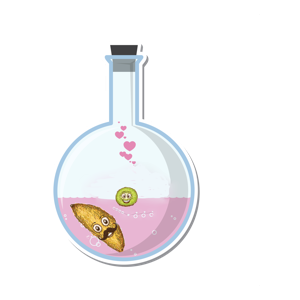Kombucha: What Can Go Wrong. 5 Things you must know.
Nemesis of Kombucha - none of which are harmful to humans though each may cause stress and discomfort.
Kombucha Tea is simply fermented Sugar and Tea with our SCOBY.. While others refer to SCOBY as a Symbolic Colony of Bacteria and Yeasts; Life in the tea brew, in reality, is a struggle and constant battle for domination.. Therefore I define SCOBY as a Serendipitous Collection Of Bacteria and Yeasts
- Yeast. Yeast feed on nitrogen and the nutrients from the tea. While oxygen levels (both dissolved and surface) are good the yeast happily reproduce creating babies, carbonation, and limited alcohol. When oxygen is diminished the yeast use the sugar to breathe and switch to fermentation phrase creating more alcohol as a by-product. As the sugar is consumed the yeast dwindle and go dormant.
- infiltration and competition from airborne or added microbes from teas, sugars, herbs, spices that were not sterilized. Kombucha remains a Folk Tradition (pickling & fermenting) in its recipes and does not undergo the standard sterilization process of any of its cousins in the Brewing Arts (Beer, Wine, Cider, Mead, Vinegar)
- Off colors and variations may produce good - even great Kombucha Tea, but the Best SCOBY is one that is creamy, smooth, and uniform. Looks and feels beautiful. The SCOBY reflects the health of your kombucha.
- About 50 microbes produce a Biofilm. Some healthy like Brettanomyces (a yeast) or Pediococcus ( bacteria) and are common and form smooth-kombucha like surfaces. Most (including the above) are unwanted and interfere with the Gluconic / Acetic Acid Balance. Though their contribution to taste and health may be encouraged.
- Vinegar Flies
- Vinegar Flies and their larvae eat the yeasts. Vinegar fly larvae are slightly larger than Vinegar eels though they look similar.. Vinegar flies and larvae can be seen feeding _on top_ of the SCOBY. They leave holes and “trails” They appear and disappear just like that. The Kombucha Tea and SCOBY are still viable and non-toxic, but many folks discard all and start over.
- infiltration and competition from airborne or added microbes from teas, sugars, herbs, spices that were not sterilized. Kombucha remains a Folk Tradition (pickling & fermenting) in its recipes and does not undergo the standard sterilization process of any of its cousins in the Brewing Arts (Beer, Wine, Cider, Mead, Vinegar)
- Bacteria. The bacteria also feed on the nitrogen and nutrients in the tea. But they prefer alcohol. (so human male like, eh: they love alcohol, sugar and caffeine). The bacteria require oxygen (to consume alcohol and as a by-product create acetic acid). Bacteria conjugate at the surface where the oxygen is greater. There they create the kombucha "mushroom" . The mushroom serves to seal off and suffocate the yeasts. to force them into the fermentation phrase. Now as the yeast population diminishes the bacteria population grows. The bacteria now have access to alcohol, nutrients and with greater access to glucose produce the mushroom, the acetic acid and gluconic acid which makes kombucha tea unique.
- Vinegar Eels
- Vinegar Eels eat bacteria destroying the mushroom. The mushroom will fall and peel apart in your hands. Zillions of eels will appear. They can be seen in constant motion along the outside rim of the SCOBY at the surface and all throughout the liquid and within the yeasts sediment. Best to send entire contents to a friend who has an aquarium. (they feed the eels to their fish). He'll thank you for your gift.
- Bacteriophage.
- Bacteriophage infect the bacteria only. Most phages range in size from 0.024 microns (24 nm) to 0.2 microns (200 nm) Impossible to see or home-test for. Extremely widespread. Non-toxic to humans. Bacteriophage are specie specific. Often used in early (and sometimes present) medicinal treatments. Some reports that's the secret healing power of the Ganges River. The results of an infestation:
- SCOBY OK - Tea OK
- No SCOBY - Tea OK
- No SCOBY - No TEA No Kombucha.
- Bacteriophage infect the bacteria only. Most phages range in size from 0.024 microns (24 nm) to 0.2 microns (200 nm) Impossible to see or home-test for. Extremely widespread. Non-toxic to humans. Bacteriophage are specie specific. Often used in early (and sometimes present) medicinal treatments. Some reports that's the secret healing power of the Ganges River. The results of an infestation:
- Vinegar Eels
3. Mold.
Mold almost always FUZZY or DRY and DUSTY. In the first few days, for most people, its hard to tell the difference. Wait a few more days as it grows it becomes clearer.The mold will become distinct from the mushroom.. Mold always grows on the surface or above the surface. Different colors, typically circular shaped. Many kombucha authors state its OK to simply rinse off or remove and to continue to ferment. Numerous lab studies indicate that a properly fermented kombucha tea with the typical pH below 3.5 is anti-pathogenic to almost all human pathogens. We recommend to use the same discretion you use in any of your food.
4. Human error. Probably the greatest Kombucha threat.
- Neglect
- Intent.
5. Always have a Plan B ready


